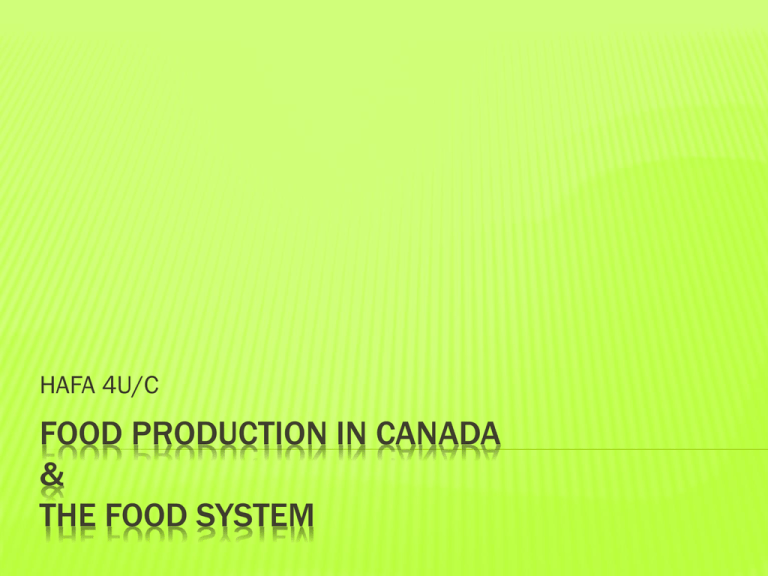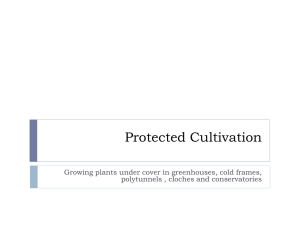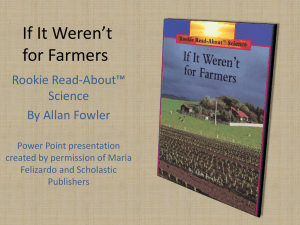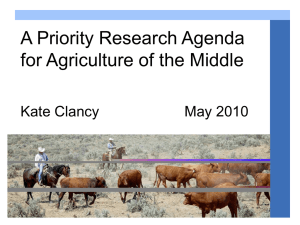Food system
advertisement

HAFA 4U/C FOOD PRODUCTION IN CANADA & THE FOOD SYSTEM BACKGROUND Canada as we discussed is a large nation with many climate zones and a wide variety of geological formations, climates and ecological systems. Canada also contains micro-climate areas where the climate will differ from the larger surrounding area. Micro- climates can be as small as one field or as large as many hectares of land. Examples: The Annapolis Valley of Nova Scotia is located between two mountain ridges the resulting micro-climate gives the valley mild temperatures that allow farmers to grow fruit and vegetable crops. In BC in The Peace Valley the Rocky Mountains funnel warm pacific air east into an area typically dominated by arctic air masses – the resulting micro-climate makes this the best grain growing area in Canada. The only desert in Canada is in Southern B.C the Osoyoos area allows for the harvest of the earliest fruits and vegetables in all of Canada ANIMAL PRODUCTION IN CANADA The Conference Board of Canada reports that Canada is the fourth largest agriculture and agri-food exporter in the world Animal production is the largest Canadian agricultural sector and includes: red meat, poultry, eggs and dairy. Agri-food: food produced agriculturally as opposed to food that is hunted, fished or gathered from the wild. BEEF, PORK & LAMB Are the most common red meats raised in Canada. In Canada there are approximately 83,000 cattle farms and ranches. Canada produces 1.2 billion kilograms of beef annually and is sized as the largest beef exporting country – primarily to the United States, Japan and other Pacific Rim markets. The size of pig farms vary but over 98% of Canada’s pig farms are family owned. 31 % of Canadian pork is exported to the United States and 21 % to Japan. In 2006 only 1.2 % of Canadian farmers were sheep farmers, much of the lamb Canadians eat is imported. Question: Which provinces do you think would have the most beef farms/ranches? What are possible reasons for this? POULTRY Chicken and Turkey are Canada’s most common poultry products The per capita annual consummation of 31.5kg in 2010 Chicken is Canada’s favourite protein! In 2009, 147 Million kilograms of fresh, chilled, and frozen chicken worth more than 288.5 million was exported to 73 countries with the largest importers being the United States, the Philippines, and Hong Kong. 2010 there were 2800 regulated chicken producers in Canada providing 19 000 jobs. Ontario is the largest producer and processor of chicken in the country raising 1/3 of all chicken produced in Canada (546 turkey farms in Canada) 15% of Canadian Turkey is raised for export. EGGS The egg industry contributes 500 Million annually to the Canadian economy. Canada has 1000 registered farms with farms in every Canadian province and in the NWT. Ontario produces 39% of Canada’s eggs DAIRY Canada’s third largest agricultural sector in terms of sales following grains, and red meats. Canadian Dairy cattle population = 1.4 million animals on approximately 13, 000 dairy farms. 82% of dairy farms are in Ontario and Quebec 13% are in the western provinces and 5% in the Atlantic provinces. 30-40% of the milk produced is sold as milk the rest is used for dairy products such as butter, cheese, yogurt, and ice cream. The production of organic milk is increasing in Canada as are the production of goat and sheep milk. QUESTIONS: Describe the difference between beef and dairy production. What concerns do/should people have about the treatment of animals that are going to be sold for consumption? What might cause meat or dairy consumption to increase or decrease? FOOD CROP PRODUCTION Grains & Oil Seeds, Fruits and Vegetables, Pulses and Specialty Crops. Canada is one of the top three wheat exporters on the planet and the worlds largest producer of high protein milling wheat – prized for its superiority in pasta and baking breads. Also Canada is the leading exporter of malting barley used by brewers. Wheat is grown in many parts of Canada but a majority of which is in the western Prairies. Canada’s arid climate and rolling plains produce some of the best spring wheat in the world. However winter wheat cannot survive the harsh Canadian winters. Canola (an oilseed crop) was developed over years as rapeseed breeders in Manitoba (in the 1960’s and 70’s) cross bred traditional plants to reduce the undesirable characteristics. Canola oil is an abbreviation for Canadian Oil. The outcome was a plan that yielded food grade oil containing healthy combinations of fatty acids, Canola is now one of the most profitable commodities for Canadian farmers. WHAT ARE PULSES? Dried legumes such as peas, beans, chickpeas, lentils etc. They are a source of protein especially eaten with grains, nuts or seeds. 2010 Canada accounted for 32% of the world dried pea production and 38% of the world lentil production making it a dominant player in world trade. Question: what popular food dish that you have consumed may use pulses? HORTICULTURE Includes field and greenhouse fruit and vegetables as well as maple and honey products. Vegetables grown agriculturally in Canada include: potatoes, peas, sweet corn, carrots, beans, tomatoes, broccoli, and native fiddle heads and other lesser known vegetables. Fruit and vegetable farming requires specialized equipment and it is labour intensive. Production practices vary greatly depending on the crop being grown. FRUIT Fruits are normally associated with southern Ontario and southwest BC. However there are many small pockets of fruit production across Canada. The most common fruits grown in Canada are: apples, grapes, peaches, pears, strawberries, raspberries, blueberries, apricots, melons, cherries, plums, and nectarines. BC is the primary grower of: grapes, blueberries, and cranberries MAPLE SYRUP Canada’s maple syrup producing regions are in: Ontario, Quebec, New Brunswick and Nova Scotia. Aboriginals taught early settlers how to harvest, boil and prepare maple syrup and associated products. Question: Have you ever been to a syrup festival or gone to collect sap as a family or on a field trip? Describe this experience. HONEY AND BEEKEEPING Approximately 7000 beekeepers keep 600 000 colonies of honeybees in Canada. In addition to making honey, the honeybees also pollinate a variety of fruits, vegetables, tree nuts, oilseeds and legume. An estimated 80% of insect crop pollination is accomplished by these honeybees. SPECIALTY CROPS Are foods that do not fit into other categories such as buckwheat (despite the name this is a fruit seed), ginseng, herbs and spices, wild rice, sugar beets, medicinal plants, sunflower, safflower, and mustard seed. Canada is the largest supplier of mustard seeds in the world GREENHOUSE GROWING Tomatoes, sweet bell peppers, English cucumbers or butter lettuce from grocery stores often come from greenhouses – never grown in soil, and never exposed to natural sunlight or rain. 2011 marked the 5th straight year sales in greenhouses outsold sales in field grown vegetables. Ontario accounting for 2/3 of all greenhouse sales. Inuvik, NWT has had a commercial greenhouse since 1999 that also included community garden plots with long hours of summer sunlight they can grown multiple crops and flowers in the same greenhouse. According to the B.C Ministry of Agriculture greenhouse crops yield up to 10 times as much as crops grown in the field. Temperature, light, and humidity conditions can be precisely controlled within a greenhouse environment and the use of soilless media such as sawdust eliminates the risk of problems caused by water and disease. Air blasts are used to pollinate flowers, or beehives are sometimes placed inside greenhouses. Integrated pest management involves the use of biological predators such as lady bugs to eat harmful pests like aphids. 60% of greenhouses are able to go untreated by pesticides. VERTICAL FARMS This concept is based on the idea of eliminating the need for land in order to create greenhouses. They can place greenhouses on top of buildings that already exists Also there is the concepts that greenhouses can be built vertically almost like a high rise with many levels. Questions: Are all crops suitable for growing in greenhouses? Why or why not? Use an example in your answer. Explain how you think rooftop gardens or vertical greenhouses can be applied within Cambridge? Where could be put one? What would be some of the benefits of this? TECHNOLOGICAL ADVANCES Read the article on the green revolution. Copy into your notes the following definitions. Nanotechnology Genetic Engineering Questions: 1. Do you think the first Green Revolution between 1950-1970 was successful? Why or Why not? 2. What are the similarities or differences between the first Green Revolution and newer emerging trends/revolutions? COMMERCIAL FISHING Huge market in Canada as it is bordered by three oceans and has numerous lakes and rivers that provide an abundance of fish and marine life. Canada has one of the worlds moth valuable commercial fishing industries it is the 7th largest in the world of fish and seafood products. More than half the total catch is exported: salmon, ground fish such as halibut, and herring are amongst the most valuable; then lobster, crab, shrimp, and scallops are the most valuable seafood catches. Freshwater fisheries account for 4% of the total Canadian Landings, with pickerel, yellow fish, whitefish, northern pike and lake trout being the most common species. Although it is profitable we have to be concerned with overfishing and illegal activity that causes the ecosystems to degrade. Examples of overfishing are demonstrated by the cod fishery in Newfoundland. AQUACULTURE: THE FARMING OF FISH, SHELLFISH AND AQUATIC PLANTS Fish are raised to maturity in enclosed shelters Two main sectors in Canada: shellfish & finfish Finfish includes: salmon, cod, tilapia, and halibut. Shellfish includes: mussels, clams, and oysters. Canada ranks 4th world wide in Salmon Production – primarily in BC and New Brunswick Question: what are some concerns with aquaculture? How might it impact the ocean and ecosystems? THE FOOD SYSTEM A typical meal consists of several different fresh, prepared, or processed foods. The journey begins on a farm, in fields, rivers, oceans, ranches, and moves through the hands of many people travelling to processors, transporters, warehouses, operators, retailers, cooks, and consumers. Food system = all the processes, activities people and other resources involved in growing, harvesting, production, processing, packaging, transporting, distributing, marketing, retailing, consuming and disposing of food. Food system = interdependent links required to put food on tables at home and in restaurants and to provide food products for trade and export FOOD SYSTEM VISUAL COMPONENTS OF THE FOOD SYSTEM: 1. Inputs: Human, Natural and Other Resources Human – labour, expertise, knowledge, research. Natural – soil, seeds, water, animals, fertilizers, pesticides, compost, and fuels. Other – infrastructure, buildings, machinery, and financial supports 2. Food Production: Conventional (dominant method), industrial model, or alternative approaches. Food grown, raised, harvested or caught in a wide variety of settings around the world: Commercial farms, family farms, corporate farms, collective farms, urban agriculture, industrial farms, or mixed farms all exist. 3. Food Processing: the deliberate change or transformation in a food that occurs before it is available for consumers to eat. It can be as simple as washing carrots, to adding sweeteners and spices, to cooking, baking or dehydrating. Each step of the food value chain adds economic value to the product. Processed and packaged foods can be stored longer making distribution easier. In some cases companies/corporation own several components in the food value chain this is called vertical integration. 4. Food Distribution: food products and ingredients are often transported from site of production to a different site for processing and packaging, moved to warehouses, stored, organized and moved again to distribution centres -> finally they end up in retail outlets or food service facilities. As food products travel from farm to table, marketing makes people aware they are available for purchase. By the time a product reaches the table it has travelled many kilometers by truck, railway, ships, airplanes and has been handled by many people. Food Miles: is a term which refers to the distance food is transported from the time of its production until it reaches the consumer. Food miles are one factor used when assessing the environmental impact of food, including the impact on global warming. 5. Food Access: most people purchase food from retail outlets such as supermarkets, convenience stores, specialty stores etc. Other options: Community supported agriculture (buy from local farmers) Or some people grow their own food. The pictures are some of my own garden efforts at home We will discuss food security in depth a little later on in the unit. 6. Food Consumption: is the eating of already prepared foods and preparing food in your own home. By choosing some foods and not others consumers play a critical role in the food system. 7. Outputs: Food is the most important output of the food system however there some times are grown on farms to satisfy other markets such as flowers, fibres, or animals for racing etc. Other outputs include manure, compost and other soil enhancers. The food system also creates food waste, packaging, air and water pollution. In Toronto a single family household will discard 275 kg of food waste each year. 30% of fruits and vegetables will never make it to store shelves as they do not meet requirements for sale to consumers. Water loss through food is estimated to be at 40 trillion litres of water every year.









